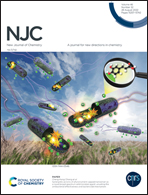Adsorption of Nd(iii) on a multistage porous imprinted chitosan composite membrane†
Abstract
The separation and recovery of neodymium from industrial pollutants and environmental sewage has become a problem of concern. However, there are still several difficulties in the practical treatment process including low pH values, low concentrations of rare earth elements, and coexistence of multiple trivalent ions, which are long-term challenges for neodymium recovery. In this paper, the synthesis of a composite membrane prepared using chitosan as an efficient adsorbent for Nd3+ is reported. The introduction of polyethylenimine into the composite membrane provided abundant protonated amino nitrogen atoms and endowed the composite membrane with excellent buffering capacity under extremely acidic conditions. Carbon nanofiber aerogels in the composite membrane can effectively improve the specific surface area and mechanical properties. Moreover, the introduction of ion imprinting technology can effectively improve the specific adsorption of Nd3+ on the composite membrane, which makes the composite membrane able to easily separate Nd3+ from other coexisting ions. The adsorption capacity of single metal adsorption for Nd3+ is 43.63 mg g−1. The composite membrane also showed good reusability, and the regeneration efficiency reached 86% after 5 cycles. The results show that the composite membrane can be used for the separation and enrichment of Nd3+ in solution.



 Please wait while we load your content...
Please wait while we load your content...